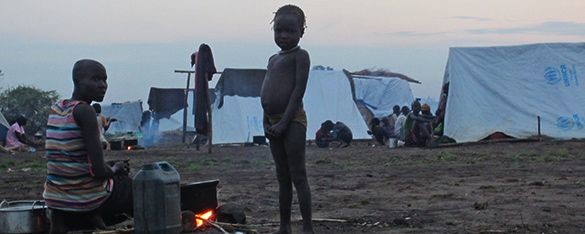Transit camps along the border between South Sudan and Ethiopia have again filled with refugees after a temporary dip in the level of refugee outflows in June, as hunger drives more people out of Jonglei and Upper Nile.
The medical organization Doctors Without Borders (MSF) says that hunger, not violence per se, is now the main driver of the migration.
“In May, South Sudanese fled because of the fighting. Now they say they have left their country because of food deprivation,” said Dr. Natalie Roberts, MSF medical coordinator in the Gambella Region of Ethiopia.
Burubiey transit camp was overwhelmed in May by an influx of about 20,000 people fleeing fighting in Nasser, Upper Nile State. By mid-June the transit camp was empty as refugees moved on to permanent camps Kule 1, Kule 2 and Leitchuor.
But by late June the migration picked up again, with between 600-800 refugees arriving at Burubiey transit camp each day, an increase from the 100-300 daily arrivals in previous weeks, according to MSF.
Besides Burubiey, other transit camps are located at Akobo and Pagak, where more than 7,700 refugees are now staying.
MSF stated in an update yesterday reported that the refugees are “walking for days seeking safe shelter and food” before reaching the Ethiopian border.
Jonglei State, which neighbors the Gambella region, has the largest population of internally displaced people in South Sudan, an estimated 435,500 people. Many of them fled SPLA attacks in Malakal, Ayod, Nasser and other areas.
“New arrivals to Kule 1 and Kule 2 camps are already malnourished. Food distribution in the camps is fragile, forcing many women, for instance, to walk nine kilometers from Kule 1 camp into town to grind their grain,” stated MSF.
As of mid-June, the global malnutrition rate among the refugees was 20% and the severe malnutrition rate was 6%.
Doctors Without Borders calls malnutrition a “serious problem,” noting that they have already treated more than a thousand seriously malnourished children at intensive care centres between March and July.
Humanitarians also consider clean water in the Ethiopian camps a “critical priority,” especially given the risk of cholera outbreak. There is an inadequate supply reported at Kule 1 camp in particular.
Currently over 140,000 South Sudanese refugees are in Gambella, MSF stated. The UN Refugee Agency (UNHCR) actually puts the figures higher, according to data on its website current to 27 June 2014.
UNCHR says that 158,164 refugees crossed into Ethiopia from South Sudan since the civil war started, while another 58,983 were already in the country.
Photo: Refugees at Lietchuor Camp, Gambella Region, Ethiopia (Aloys Vimard/MSF)
For breaking news updates from Radio Tamazuj ‘like’ our page on Facebook, follow us on Twitter, or subscribe to our RSS feed.




